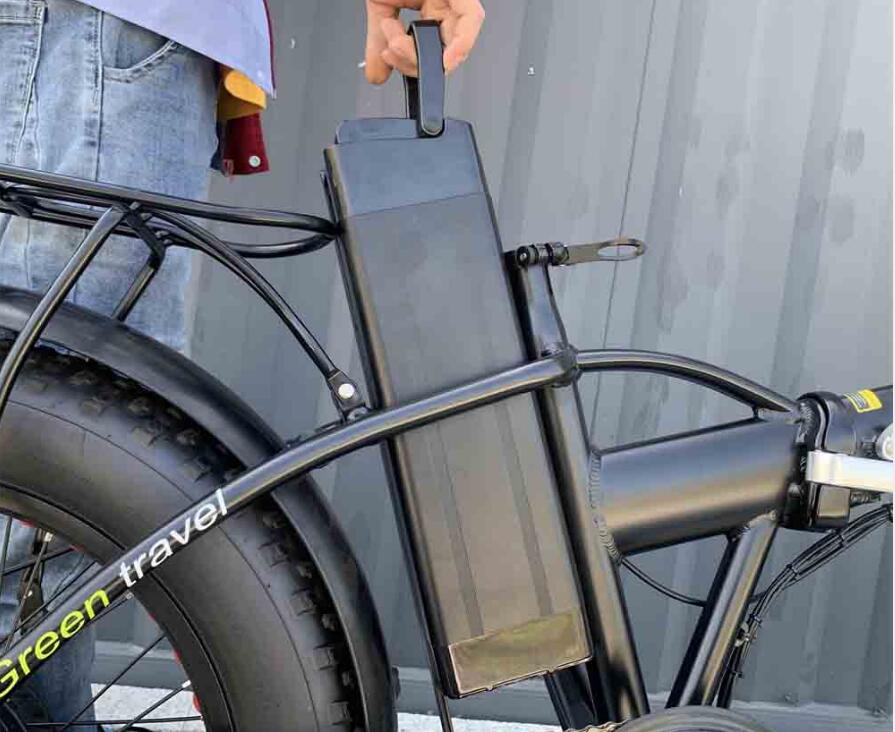Electric bikes are equipped with a wide variety of batteries, and this guide will provide basics on the prevention of damage, and care for such diverse systems.
But it is important that the reader refer to the specific instructions given in the owner’s manual for their bike, their battery, and their charger. If you do not have that document, check on line – many such manuals are posted at the website of the brand. Or contact the folks who sold the bike and ask them for a copy. Read all warning labels and tags – and then follow their instructions.

Battery Basics
A “battery” is a collection of cells that work together to achieve a desired voltage and watt hours (capacity) for the bike. Although it is correct to refer to the individual energy storage devices as cells, common usage is to refer to both cells and the complete battery as “batteries”.
There are a number of different types of cells used in electric bikes. If you want to sound like a battery expert, refer to them as “different metallurgies”. Each metallurgy has it’s strengths, weaknesses, and different requirements for care and safety. If you do not know what metallurgy your bike battery uses, ask the maker, for this can be a very important fact. Treating the battery in the wrong way can result in fire, explosion, or more commonly – a ruined battery.
Cells use an electro chemical reaction to produce electrical current. The voltage of that current is specific to the composition of the cell, and the capacity (amount of energy – also called watt hours or amp hours) is a function of the design and volume of the cell. We can determine the metallurgy of a cell by measuring the voltage that a fully charged cell puts out. (Just one cell! The voltage of the battery will be a function of the number of cells, the voltage of those cells, and how they are connected.)
Cells are active for only a few years at best, often less time than that. They can be damaged when their state of charge falls below a certain value, or when they are over charged, over heated, crushed, penetrated, etc. Such damage reduces cell performance – sometimes to zero.
Some terms that you will need as you read on:
Amp Hours – Describes the energy storage capacity of a cell or battery.
Watt Hours – Describes the energy storage capacity of a cell or battery.
Voltage – describes the energy potential of the current supplied by a cell or battery.
Battery Management System – a microchip controlled device that prevents (by limiting or shutting down the battery) over charge, over discharge, temperature events (thermal runaway), short circuits, and more. It also improves battery life and performance by balancing the cells, and provides information that can be used for determining battery health, state of charge, and more. These are necessary on advanced batteries such as NiMH, LiMa, LFP. There are some claims of lithium batteries that do not need such systems, but the most common industry practice is to use a BMS.
Cycle Life – how many times a battery can be charged and discharged before it has suffered significant degradation of performance. A deep cycle is discharging the battery all the way to the safe limit, and recharging it to full capacity. A shallow discharge is to discharge it only a little and then recharge to full. Nominal cycle life is based on deep cycles.
Max Current – How fast energy can be drawn from that battery – this limits torque, acceleration, etc.
C Rate – Another way of describing how fast energy can be drawn from a battery.
Recharge rate – how quickly energy can be returned to the battery as a function of charging.
Nominal voltage – the unique-to-the-metallurgy voltage that a cell should create.
Battery voltage – the current supplied by a collection of cells.
Parallel and Series connections – these determine the voltage of a battery package, as cells wired in parallel will deliver the nominal voltage, and cells wired in series (your common flashlight) will add each cells voltage. So battery designers will create batteries where some cells are Parallel (P) and some are in Series (S) resulting in descriptions like this. My flashlight is wired 2 S. Each cell has 1.5 volts, and the bulb is designed for 3.0 voltage operation. If I wired those two cells in parallel, I would have a very dim light because the bulb would only receive 1.5 volts

Battery Types
Batteries are expensive. The large format batteries used on electric bikes and scooters can be very expensive. It is worthwhile to take care of them.Most Popular: Lead Acid BatteriesAlso refereed to as Pb, PBA, and as SVRLA, these are the most commonly used batteries for electric bikes worldwide. They are the same metallurgy as the batteries used to start your car, for your UPS for your computer. They are a very well understood technology that has been in commercial use for more than 110 years.These look like the same batteries that are in your Uninterruptable Power Supply, or in the emergency lighting fixtures in big buildings. They are rectangular black plastic blocks with two terminals and a sticker that declares the size, capacity and voltage of this battery.Lead acid battery strengths: Inexpensive, can be very well made (depending on the supplier), 100% recyclable, can support high rates of discharge, and rarely have any issues with fire or explosion (although it can happen!). They are available from a variety of makers, distributors and retailers in standard sizes and shapes. Cycle life can vary widely by maker – but the generally expected rate is 300 cycles, with many more resulting from “shallow discharge” or recharging after a short period of use. (There is no memory effect, and this shallow discharge / charge cycle is what you create when using them as starter batteries for your car – and realizing thousands of cycles.)
This metallurgy does not need a battery management system.
- many more resulting from “shallow discharge” or recharging after a short period of use. (There is no memory effect, and this shallow discharge / charge cycle is what you create when using them as starter batteries for your car – and realizing thousands of cycles.)
- This metallurgy does not need a battery management system.are shipped with a charger that can accept only one voltage. Since ebike makers sell bikes all over the world, it is possible for you to receive a charger for the wrong mains voltage, or even with the wrong plug.
- If you are trying to connect a charger to the bike or battery, and the plug does not fit – you may be making a mistake. Stop and evaluate. Ask questions of the maker and dealer.
- BMS (and smart chargers) are supposed to protect the bike and battery against damage and provide a level of safety from fire, electrical shock, and overheat. They almost always work. But…not always. Be alert and consider what will happen and what you will do, if the hardware has been damaged or failed and either the battery fails to charge, (most likely) or a fire occurs.
-
Shock, vibration, high heat, sub freezing temperatures, water, high humidity, crushing, punctures, are all bad for batteries. Do what you can to prevent the exposure of your battery to such.
Thank you to Edward Benjamin, (Senior Managing Director of eCycleElectric Consultants LLC) for this thorough e-bike battery post. -
Read more bike tips:
Can an Obese Person Ride an E-Bike
How to Safely Store an E-Bike: Outside vs Inside
 Shuangye ebike
Shuangye ebike
